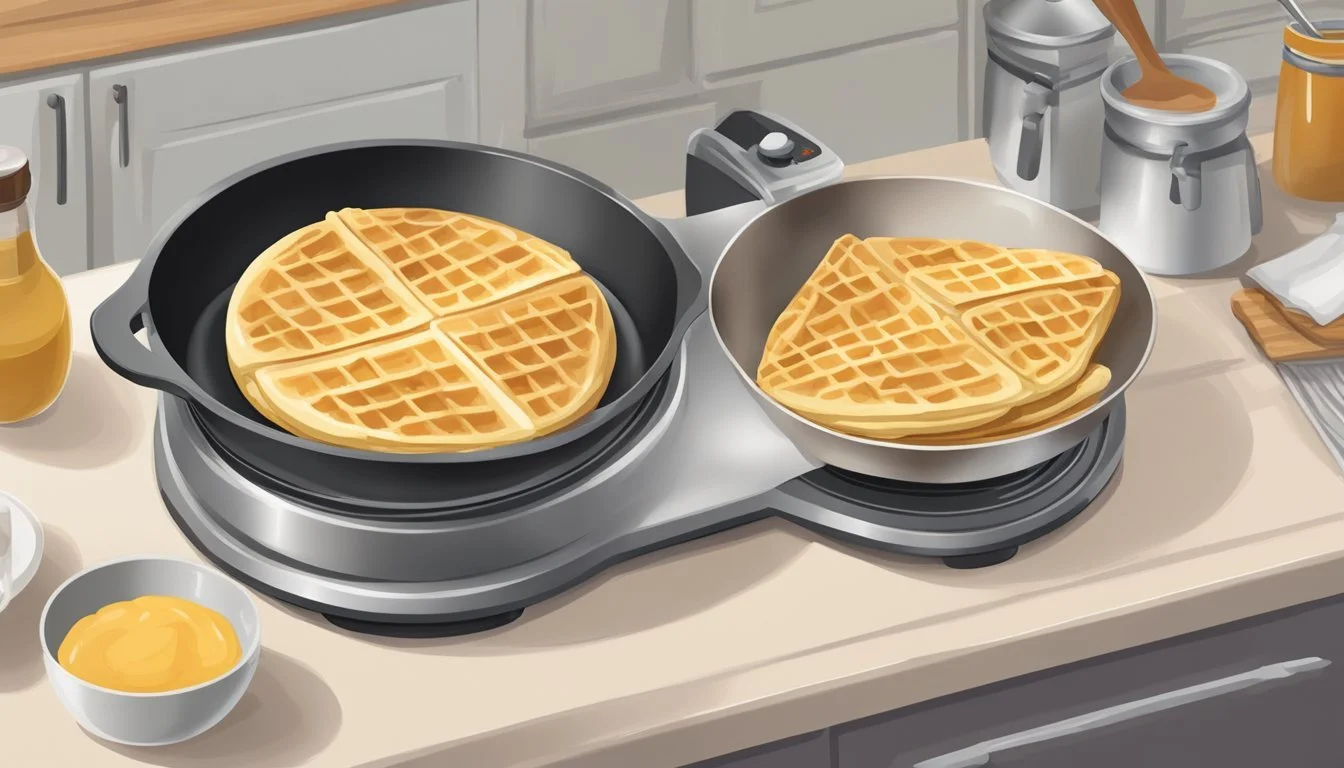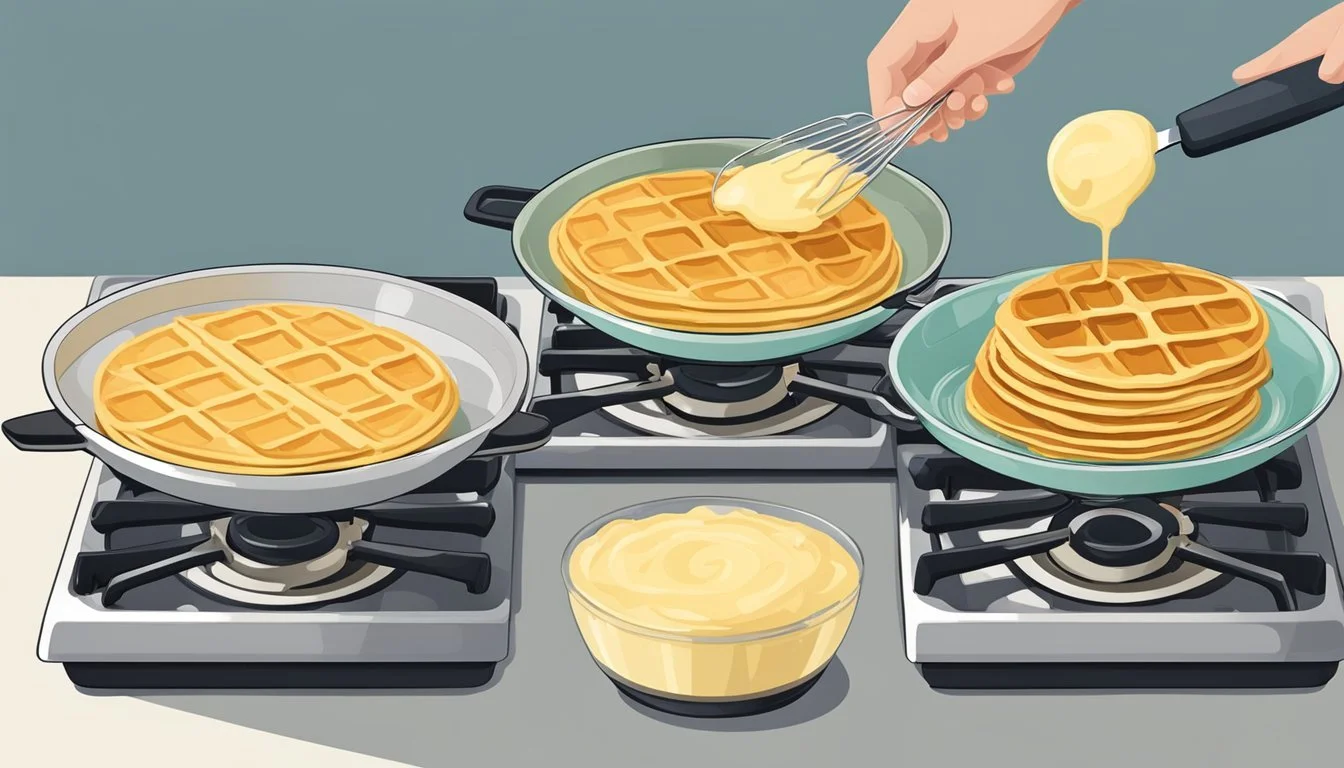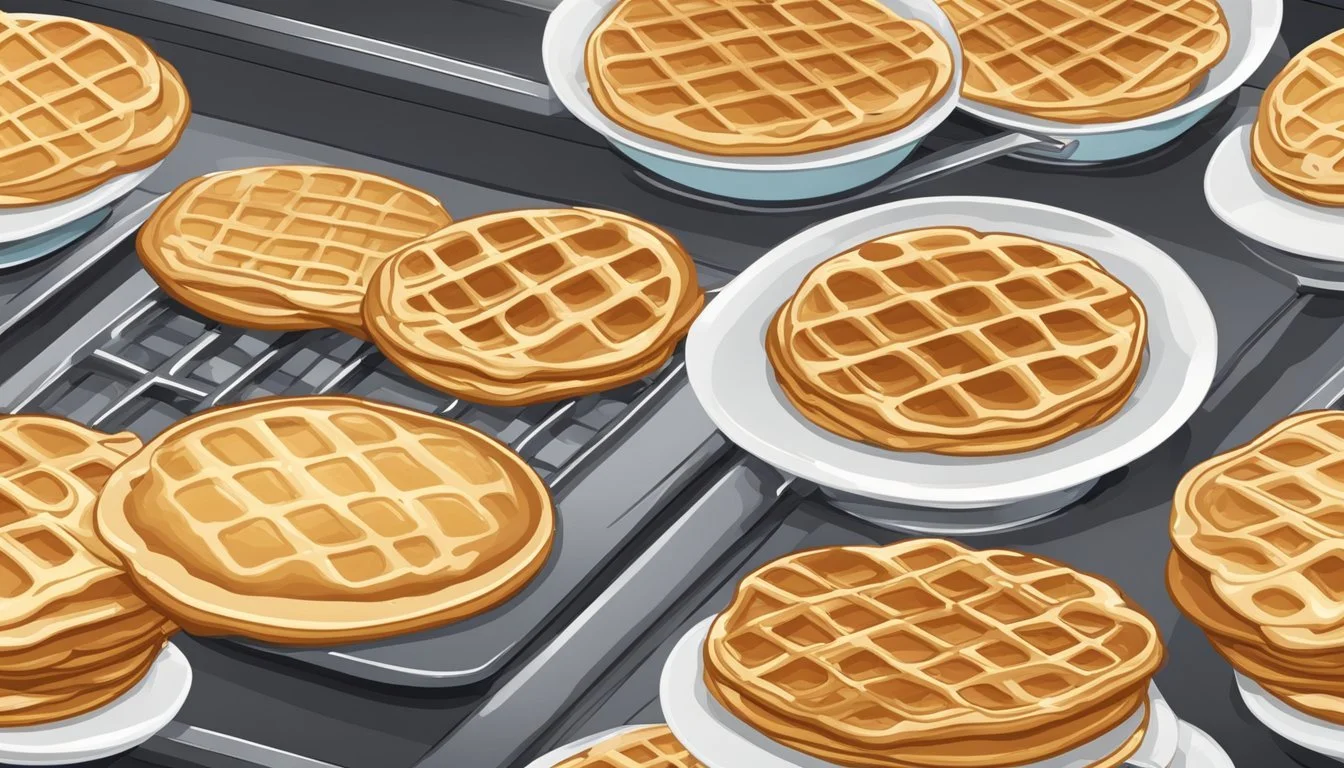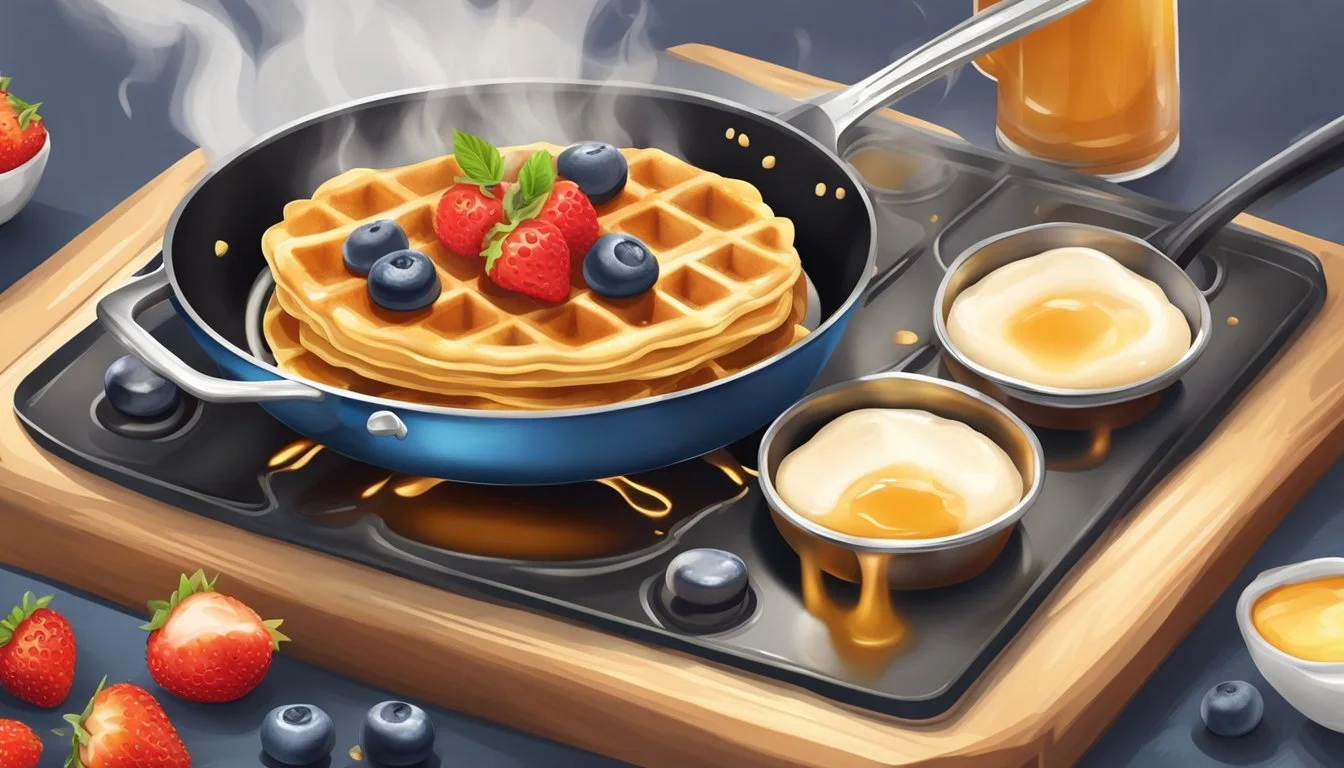No Waffle Iron? No Issue
Transform Waffle Batter into Delicious Pancakes
Waffles and pancakes are staples of the quintessential breakfast, beloved for their simplicity and versatility. It's hard to imagine a leisurely weekend morning without the aroma of freshly made batter cooking to a perfect golden hue. However, not every kitchen is equipped with a specialized waffle iron, and many people might hesitate to indulge in making waffles because of it. The good news is that waffle batter can be transformed into a delightful pancake that offers a similar flavor profile and an equally satisfying breakfast experience.
The differences between waffle and pancake batter are subtle, with waffle batter typically containing more fat and sometimes a leavening agent like yeast to create a crispier and fluffier texture. These modifications to the batter are designed to complement the grid pattern of a waffle iron. Yet, when one does not have access to this appliance, the batter can be easily cooked on a regular pan or skillet. The result? A waffle-flavored pancake with a slightly denser texture that carries the essence of its waffle counterpart, complete with nooks and crannies for absorbing syrup and toppings.
Breakfast enthusiasts can still enjoy the indulgence of a delicious waffled breakfast without the need for specialized equipment. Utilizing techniques like baking in a silicone mold or using a stovetop grill pan, home cooks can achieve that charming waffle taste and bring creativity to their breakfast table. Whether served with a drizzle of maple syrup, a dollop of whipped cream, or a heap of fresh fruit, these waffle-inspired pancakes prove that a lack of a waffle iron is not an obstacle but an opportunity to innovate in the kitchen.
Understanding the Basics
When making waffle batter pancakes, it's pivotal to recognize the distinctions in batter consistency and the role of leavening agents to achieve the desired texture and flavor.
Comparison of Waffle and Pancake Batter
Waffle batter and pancake batter may share several ingredients, but they diverge in their ratios leading to distinct textures. Waffle batter is typically richer and contains more fat in the form of butter or oil, which contributes to a crispy exterior once cooked. Pancake batter, on the other hand, has a lighter fat content allowing it to spread smoothly on a griddle and cook into a soft and fluffy texture.
Ingredient Waffle Batter Pancake Batter Flour All-purpose All-purpose Leavening Agents Higher amount Lower amount Eggs More, often separated Usually whole Fat (butter or oil) Higher content Lower content Sugar Can be higher Typically less Liquid (milk or buttermilk) Often buttermilk for tanginess Milk for lightness
Leavening Agents: Baking Soda and Baking Powder
Baking soda and baking powder are chemical leavening agents that release carbon dioxide when activated, causing the batter to rise and become airy. The key difference is that baking powder contains both an acid and a base and begins to act the moment it is wet, whereas baking soda requires an acidic ingredient to activate.
Baking powder is often used in pancake batter to achieve fluffiness and a tender crumb. Since waffle batter incorporates more sugar and is cooked at a higher temperature, the additional sweetness can caramelize to create a crisp exterior, complemented by the higher usage of baking powder or a combination with baking soda for lift and browning.
Leavening Agent Activation Usage in Waffle Batter Usage in Pancake Batter Baking Soda Requires acid With acidic ingredients Rarely alone Baking Powder Activates with moisture For rise & browning For light fluffy texture
Creating the Batter
Crafting the perfect batter is fundamental to making waffle batter pancakes. This section guides the reader through selecting the best ingredients, mastering the mixing technique to maintain an ideal consistency, and ensuring the batter is airy for that characteristic fluffiness.
Selecting the Right Ingredients
For a delicious waffle pancake, one must carefully choose quality ingredients. The foundation is all-purpose flour, complemented by a suitable amount of sugar to create a balanced sweetness. Adding a pinch of salt enhances the flavors and a strategic use of baking powder acts as a leavening agent. Fats, such as butter or oil, add richness, while milk contributes to the smoothness of the batter. Fresh egg whites are key to an airy texture, as they will be beaten to incorporate air bubbles into the batter.
Flour: 2 cups all-purpose flour
Sugar: 2 tablespoons sugar
Baking Powder: 1 tablespoon baking powder
Salt: a pinch
Milk: 1 ¾ cups
Butter: Melted, quantity as per recipe
Egg Whites: From 2 large eggs
Mixing Technique to Avoid Overmixing
Overmixing the batter can lead to dense and chewy pancakes, so one must mix just until the dry ingredients are wetted. Start by combining all dry ingredients thoroughly before introducing the wet ingredients. Mix the wet ingredients in a separate bowl—melted butter, milk, and egg whites—before gently folding them into the dry mix. The goal is a slightly lumpy batter; a few streaks of flour are permissible and are preferable to an overworked mixture.
Incorporating Air for Fluffiness
The secret to fluffy waffle pancakes lies in the incorporation of air; this is achieved by beating the egg whites until stiff peaks form. They should be gently folded into the batter in stages to preserve the bubbles that will expand upon cooking, giving the pancakes their airy rise. It's important that the other ingredients are at room temperature to prevent the fat from solidifying, which can deflate the air pockets and affect the fluffy consistency.
Tools and Techniques
Creating waffle-textured pancakes without a waffle iron is achievable through specific tools and techniques. The correct choice of cooking surface, utensils, and non-stick solutions is essential for a satisfying result.
Alternative Cooking Methods
One can use a grill pan or a sandwich press to mimic the texture of waffles when a waffle iron isn't available. Heating these pans over medium heat is crucial, and the batter should be cooked until golden brown, ensuring a crispy exterior akin to traditional waffles.
Choosing the Right Pan or Griddle
A heavy-duty griddle pan, preferably cast iron, is ideal; it delivers consistent heat, important for even cooking. Meanwhile, a standard non-stick pan can suffice but might not provide the same waffle-like indentations that a grill pan would.
Recommended Utensils for Making Pancakes
A spatula is the essential utensil to have on hand. It should be wide enough to support the pancake when flipping. For mixing and pouring batter, a ladle or pitcher can provide control and ease of use.
Non-Stick Solutions for Easy Flipping
To ensure pancakes release easily, one can either use a non-stick cooking spray or a small amount of oil or butter applied with a paper towel. This not only aids in flipping but also contributes to the golden color and crisp texture.
Tweaking Texture and Flavor
Crafting the ideal texture and flavor profile for waffle batter pancakes involves fine-tuning the crispiness of the edges and enriching the overall taste. This can transform an everyday pancake into one that conjures up the classic waffle experience without the need for a specialized iron.
Achieving Crispy Edges
To give pancakes that sought-after crispy edge reminiscent of waffles, one should consider the cooking fat used. Butter is a traditional choice that not only promotes browning but also adds a rich flavor. Alternatively, coconut oil can be used for a slight coconut aroma and to obtain crispiness. Medium-high heat and a pre-heated pan also play crucial roles in acquiring that signature crisp edge.
Enriching the Flavor Profile
The flavor profile of waffle batter pancakes can be enhanced by incorporating select ingredients into the batter. Adding a pinch of salt can intensify existing flavors, while a splash of vanilla extract introduces a warm, comforting note. For richness, blend in melted butter or even infuse the batter with maple syrup for a subtle sweetness that pairs well with additional toppings.
Sweet and Savory Variations
Waffle batter pancakes allow for creative sweet and savory interpretations. Sweet variations might include mixing chocolate chips or diced fruit into the batter for bursts of flavor. For a savory twist, incorporating crumbled bacon can offer a delightful contrast, especially when the pancakes are served with a drizzle of syrup or honey.
By considering these factors, one can successfully mimic the charm of traditional waffles using a simple pancake skillet, satisfying both crispy texture cravings and a rich palette of flavors.
Finishing Touches
Once your waffle batter pancakes are cooked to perfection, it’s time to elevate them with the right finish. This involves selecting delectable toppings and the art of presentation to make them irresistible.
Choosing Toppings
Whipped Cream: A dollop of light, airy whipped cream adds a luxurious texture.
Fruit: Fresh fruit such as sliced strawberries, bananas, or a berry compote can introduce a refreshing and slightly tangy contrast.
Syrup: Drizzle maple syrup for classic sweetness or consider honey or agave nectar for alternative options.
Chocolate Chips: Sprinkle chocolate chips while the pancakes are still warm, allowing them to melt slightly.
Ice Cream: A scoop of vanilla ice cream turns breakfast into dessert.
Chopped Nuts: Toasted almonds, walnuts, or pecans contribute crunch and nutty flavors.
Serving Suggestions
Serve your waffle batter pancakes on a warm plate to maintain their heat. If serving a stack, layering each pancake with a spread of choice — such as peanut butter or chocolate spread — can add more depth to the flavors. For an elegant presentation, a light dusting of powdered sugar or a drizzle pattern with syrups and sauces can make the dish visually appealing. Pair with a hot beverage such as coffee or tea, or a cold glass of milk to balance the richness.
Tips and Tricks
In the quest for waffle-like pancakes without an iron, it's all about technique. Knowing how to prep your batter and griddle will affect the end result. Follow these tips to ensure a satisfying, waffle-inspired pancake experience.
Preparation Hacks
Choosing the Right Batter: Any waffle batter works for making waffle pancakes. The key is to aim for a thicker consistency to mimic the texture of waffles.
Using the Correct Pan: Utilize a grill pan or sandwich maker for that characteristic waffle indentation. A regular non-stick skillet can be used as well.
Oil or Butter: To prevent sticking and achieve a golden crust, use either vegetable oil or melted butter for greasing the pan. A brush or paper towel ensures even distribution.
Oil Purpose Vegetable Oil Provides a neutral taste, less likely to burn Melted Butter Adds a rich, buttery flavor to pancakes
Heat Level: Preheat the pan over medium heat, adjusting as needed to prevent burning.
Batter Pouring: For even cooking, pour the batter into the center and spread gently. This simulates the even spread in a waffle iron.
Cooking Time: Approximately 2-3 minutes per side should suffice. Look for a golden brown color and crisp edges as indicators of doneness.
Storage and Reheating for Best Quality
Cooling Down: Allow pancakes to cool on a wire rack to maintain crispiness.
Storing: Place cooled pancakes in an airtight container, separating layers with parchment paper to prevent sticking.
Storage Location Duration Notes Refrigerator Up to 3 days Preserve freshness Freezer Up to 2 months Ideal for longer-term storage
Reheating: To recapture the initial texture, reheat on a pan or in a toaster until warm and crispy.
Microwave Warning: Avoid microwaving as it softens the texture, detracting from the waffle-like crispiness.
By keeping these tips in mind, chefs can easily create delicious, waffle-textured pancakes that satisfy the craving without the need for a specialty appliance.
Understanding the Equipment
In the world of waffles, the equipment is central to creating that classic texture and shape. While a traditional waffle iron imprints the familiar pattern, other kitchen tools can also yield delicious results.
Alternatives to a Waffle Iron
For those lacking a waffle iron, several household appliances can serve as substitutes. A grill pan with raised ridges can mimic the waffle iron's pattern and create a waffle-textured pancake. In the absence of a grill pan, a sandwich maker or silicone waffle molds in the oven can also be effective. These alternatives do not create the exact pattern but provide a similar end product with pockets and a satisfying crunch.
The Role of Metal Plates and Ridges in Traditional Waffles
Traditional waffle makers consist of two metal plates with characteristic ridges and patterns, which heat batter into the iconic obelios shape. The metal plates of a non-stick waffle iron are engineered to distribute heat evenly and create a consistent golden-brown finish. Notably, the ridges serve both aesthetic and culinary functions, imparting aesthetics while also promoting even cooking and crispiness.
By understanding the function of the waffle iron's design, one realizes that it's the combination of heat and pressure on batter between patterned plates that defines a waffle's texture. When opting for alternatives, achieving similar effects requires careful heat management and the use of tools to emulate the pressure and patterns.
Historical and Cultural Context
This section explores the progression of waffle and pancake preparation from their medieval origins to their modern-day status as beloved brunch staples.
Waffles in Medieval Europe
The advent of waffles in Europe can be tied to the Middle Ages, with the first waffle irons dating back to the 14th century. These primitive tools featured two hinged plates, usually made of cast iron, that pressed together to cook batter over an open flame. Waffles during this time were not just a culinary delight but often bore religious and cultural insignia, with patterns that could be ornate and symbolically significant.
Pancakes and Waffles: A Brunch Staple
Pancakes share a similar ancient lineage, with evidence suggesting they were prepared and consumed as far back as 30,000 years ago. Modern pancakes and waffles both enjoy a revered place in the context of brunch (What wine goes well with brunch?), a meal that seamlessly blends the lines between breakfast and lunch. The versatility in toppings and recipes for both pancakes and waffles has allowed them to travel beyond the confines of Medieval Europe and evolve into a universal treat, beloved across various cultures and regions.
Health and Dietary Adaptations
Crafting pancakes from waffle batter isn't just a culinary improvisation—it's also an opportunity to cater to specific health and dietary needs. Vegan versions and adapted recipes for other restrictions ensure that the delectable transformation of waffle batter into pancakes is accessible to a wide range of dietary preferences.
Making Vegan Pancakes Using Waffle Batter
To create vegan pancakes with waffle batter, one must replace eggs and milk, common non-vegan ingredients. A popular egg substitute is a "flax egg," made by mixing 1 tablespoon of ground flaxseed with 2.5 tablespoons of water for each egg. Plant-based milk options like almond, soy, or oat milk can seamlessly replace cow's milk to add moisture and richness to the batter. For butter, one can use melted coconut oil or a commercial vegan butter. Utilizing these substitutes, one can easily whisk together a deliciously homemade vegan waffle batter from scratch, achieving a similar flavor and texture profile to traditional recipes.
Traditional Ingredient Vegan Substitute Eggs Flax eggs Milk Plant-based milk (almond, soy, oat) Butter Coconut oil or vegan butter
Adjusting Recipes for Dietary Restrictions
When accommodating other dietary restrictions, such as gluten intolerance, one can use gluten-free all-purpose flour in place of traditional wheat flour. It's essential to read labels at the grocery store carefully, as some gluten-free flours have different consistencies and may affect the texture of the pancakes. Many all-purpose flours nowadays come fortified with nutrients to match the health profiles of their wheat counterparts, ensuring that no dietary needs are compromised. For individuals monitoring their sugar intake, natural sweeteners like maple syrup can be used in moderation within the batter, or as a flavorful topping. It's worth experimenting with ingredient proportions in a recipe to achieve pancakes that are not just safe for consumption but also deliciously tailored to personal dietary requirements.
Advanced Techniques
Mastering advanced techniques ensures the transition from good to great waffle-pan pancakes. The cook’s ability to manipulate batter and cooking temperature plays a pivotal role in achieving the desired texture, whether aiming for crispy or chewy outcomes.
Creating the Perfect Leavened Batter
The key to an airy, leavened batter lies in the careful selection and use of leavening agents. For leavened batter, one typically relies on baking powder or yeast. Baking powder is ideal for immediate cooking, while yeast will require time to rise, imparting a distinct flavor and additional fluffiness.
Ingredients for Leavened Batter (using baking powder):
2 cups all-purpose flour
2 tablespoons sugar
1 tablespoon baking powder
1/2 teaspoon salt
2 large eggs
1 3/4 cups milk
1/2 cup melted butter or oil
1 teaspoon vanilla extract (optional)
Mix the dry ingredients thoroughly before incorporating the eggs, milk, melted fat, and vanilla. This ensures even distribution of the leavening agent, resulting in a uniform rise during cooking.
Cooking for Texture: Crispy vs Chewy
The texture of waffle-pan pancakes is significantly affected by the cooking method and the type of fats used in both the batter and the cooking surface.
Crispy Texture:
Preheat the pan to a medium-high temperature.
Use a fat with a high smoke point, like canola oil or clarified butter, to grease the pan.
Cook until the edges are well-defined and the surface is golden brown.
Chewy Texture:
Use a lower heat setting to cook the pancakes more slowly.
Include a fat like whole butter in the batter to add moisture.
Cook until just set but without letting the edges crisp too much.
For crispiness, the cook should employ high heat briefly, ensuring a quick cook time that locks in the structure while avoiding burning. In contrast, a chewier texture demands lower temperatures and possibly a thicker batter that retains moisture throughout the cooking process.











